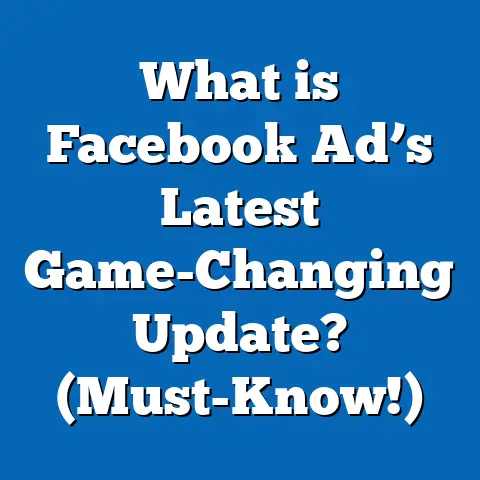What is Demographic Targeting in Facebook Ads? (Unlocking Potential)
What is Demographic Targeting in Facebook Ads? (Unlocking Potential)
Introduction: A Joke to Kick Things Off
Why did the marketer break up with the broad audience? Because they just weren’t targeting their feelings!
Marketing humor aside, when it comes to Facebook advertising, understanding exactly who your audience is can make or break your campaign. With billions of users on Facebook, casting a wide net often means wasting resources on people who will never convert. This is where demographic targeting shines—by helping you focus your ads on those who matter most.
In this extensive guide, we will explore everything you need to know about demographic targeting in Facebook ads, from the basics to advanced strategies, backed by data, case studies, and actionable tips. Whether you’re a marketing professional looking to sharpen your skills or a business owner wanting to boost your ad performance, this guide will unlock the true potential of demographic targeting.
Table of Contents
- What Is Demographic Targeting in Facebook Ads?
- Why Is Demographic Targeting Crucial for Facebook Advertisers?
- The Full Spectrum of Demographic Options on Facebook
- How Facebook Collects and Uses Demographic Data
- Deep Dive into Facebook’s Ad Manager: How to Set Up Demographic Targeting
- Real-World Case Studies Demonstrating Success with Demographic Targeting
- Advanced Strategies: Combining Demographics with Other Targeting Methods
- Challenges and Ethical Considerations in Demographic Targeting
- Comparing Facebook’s Demographic Targeting with Other Advertising Platforms
- The Future of Demographic Targeting on Facebook
- Practical Tips for Marketers and Business Owners
- Summary and Next Steps
1. What Is Demographic Targeting in Facebook Ads?
Demographic targeting is a method of segmenting an audience based on specific personal characteristics such as age, gender, income level, education, marital status, job title, and more. On Facebook, this targeting is powered by the enormous volume of user data that the platform collects through user profiles, interactions, and external data partnerships.
This approach enables advertisers to serve their ads only to those who fit their target profile rather than showing ads indiscriminately.
Breaking It Down
Think of demographic targeting as addressing a letter:
- Without targeting: You send the letter to everyone in the country.
- With demographic targeting: You send it only to people living in certain cities within a specific age group who have interests relevant to your message.
This focused approach increases the likelihood that your ads will resonate with the audience and drive desired actions.
2. Why Is Demographic Targeting Crucial for Facebook Advertisers?
The Scale of Facebook’s Audience
As of early 2024, Facebook boasts approximately 2.91 billion monthly active users worldwide (Statista). This massive scale means audiences are diverse across many factors — age ranges from teenagers to seniors, interests span every conceivable niche, and incomes vary widely.
Without targeting, your ads risk being lost among irrelevant users.
Benefits of Demographic Targeting
- Cost Efficiency: Narrowing your audience reduces wasted ad spend by avoiding users unlikely to engage.
- Higher Engagement: Ads tailored for specific demographics tend to have higher click-through rates (CTR) and interaction.
- Better Conversion Rates: When your ad matches user profiles, conversion rates improve significantly.
- Improved ROI: More relevant ads lead to better return on investment.
A HubSpot survey from 2023 found that 72% of marketers experienced improved conversion rates after implementing demographic targeting on Facebook.
Supporting Data
| Metric | Data Point |
|---|---|
| Increase in Conversion Rate | +35% with demographic targeting (eMarketer 2023) |
| Average CTR Improvement | +45% when combined with interest targeting (WordStream 2023) |
| Cost per Acquisition Reduction | Up to 25% lower (Facebook Business Insights) |
These figures demonstrate that demographic targeting isn’t just a nice-to-have but a strategic necessity.
3. The Full Spectrum of Demographic Options on Facebook
Facebook provides a wide array of demographic filters under its advertising platform. Understanding these options allows advertisers to build precise audience profiles.
Age and Gender
- Minimum age: 13 years (due to platform policies)
- Age brackets can be customized (e.g., 18-24, 25-34)
- Gender options: male, female, or all
Location
- Country-level targeting
- State/province-level
- City-specific or postal code targeting
- Radius targeting around a point (useful for local businesses)
Education
- Education level: some high school, high school graduate, some college, college graduate, postgraduate
- Fields of study: e.g., business administration, computer science
- Schools attended (target alumni or current students)
Income and Financial Status
- Household income brackets based on census data or third-party sources
- Net worth estimates in certain countries (U.S., Canada)
Relationship Status and Life Events
- Single, married, engaged, divorced
- Life events like birthdays (within 1 week), anniversaries, recent moves, new jobs
Work and Industry
- Job titles: e.g., marketing manager, software engineer
- Employers: target employees of specific companies
- Industries such as finance, healthcare
Ethnic Affinity & Generation
- Ethnic affinity groups (primarily available in the U.S.)
- Generational cohorts: Baby Boomers, Gen X, Millennials, Gen Z
Other Special Categories
- Parents with children in specific age ranges
- Homeownership status
- Political affiliation (limited by policy)
4. How Facebook Collects and Uses Demographic Data
Facebook’s ability to offer such granular demographic targeting stems from multiple data sources:
User Profiles
When people create accounts or update information, they provide age, gender, education history, work info, and more.
User Behavior on Platform
Likes, follows, comments, shares—all these activities reveal user interests and indirectly validate demographic attributes.
Third-Party Data Partnerships
Facebook partners with data aggregators who provide additional offline data like purchase behavior or income estimates.
Pixel and SDK Tracking
Facebook Pixel installed on advertiser websites tracks user behavior off-platform—product views or purchases—which can be linked back to demographics.
Privacy Compliance Measures
Since privacy concerns have grown (e.g., GDPR in Europe), Facebook anonymizes and aggregates some data but still provides detailed enough insights for targeting.
5. Deep Dive into Facebook’s Ad Manager: How to Set Up Demographic Targeting
To use demographic targeting effectively, understanding the interface and options in Facebook Ads Manager is key.
Step 1: Choose Your Campaign Objective
Common objectives include:
- Brand awareness
- Traffic
- Engagement
- Lead generation
- Conversions
- Catalog sales
The objective influences available optimization options.
Step 2: Define Your Audience in the Ad Set Level
Within the Ad Set tab:
- Location: Enter countries or narrow down by city or postal code.
- Age: Set minimum and maximum age limits.
- Gender: Select male, female or all.
- Languages: Optional filter if targeting specific language speakers.
- Detailed Targeting: Click “Edit” under this section to add demographics including education, income brackets, relationship status.
- Connections: Target people connected to your page or exclude them.
- Narrow Further: Use “Narrow Audience” feature to layer multiple conditions.
- Exclude: Remove certain demographics or interests from your audience.
Step 3: Save Your Audience for Future Use
Once configured, save your audience for easy reuse or building lookalike audiences later.
6. Real-World Case Studies Demonstrating Success with Demographic Targeting
Case Study 1: Fashion Brand Boosts Sales by 40%
Objective: Launch new sustainable summer collection.
Targeting Strategy:
- Women aged 25–40
- College educated
- Interest in sustainability & eco-friendly fashion
- Located in metropolitan areas with household income > $60k
Results:
- Sales increased by 40%
- Cost per acquisition dropped by 25%
- Engagement rate doubled compared to prior campaigns without demographic focus
Case Study 2: Local Gym Increases Membership Sign-Ups by 50%
Objective: Attract new gym memberships in a metro area.
Targeting Strategy:
- Men and women aged 18–45
- Living within a 15-mile radius of gym location
- Interests in fitness apps, workout routines
- Excluded people already members or frequent visitors
Results:
- Membership sign-ups rose by 50% over three months
- CTR improved by over 30%
Case Study 3: B2B SaaS Company Drives Quality Leads Using Job Title Targeting
Objective: Generate leads for project management software.
Targeting Strategy:
- Age 25–55
- Job titles: Project Managers, Team Leads
- Industries: Technology, Consulting
- Education level: College degree or higher
Results:
- Lead quality improved significantly; 60% higher demo request conversion rate
- Cost per lead decreased by 20%
7. Advanced Strategies: Combining Demographics with Other Targeting Methods
Demographic targeting alone is powerful but combining it with other methods yields even better results.
Interest-Based Targeting
Target users based on their interests such as hobbies or pages they follow (e.g., “Yoga,” “Organic Food”).
Behavioral Targeting
Focus on users’ behaviors like recent purchases or device usage.
Lookalike Audiences Based on Demographics
Create audiences resembling your best customers filtered by demographics using Facebook’s AI algorithms.
Retargeting and Custom Audiences
Use pixel data to retarget users based on website visits combined with demographic filters for precision.
8. Challenges and Ethical Considerations in Demographic Targeting
Privacy Concerns and Regulatory Challenges
Privacy laws such as GDPR limit how personal data can be used. Apple’s iOS 14+ update restricts app tracking transparency—reducing data granularity for advertisers.
Marketers should:
- Use first-party data responsibly.
- Be transparent about data use.
Avoiding Stereotyping and Bias
Demographic targeting can unintentionally reinforce stereotypes or exclude certain groups unfairly.
Best practices:
- Regularly review targeting assumptions.
- Use diverse creatives that respect all demographics.
9. Comparing Facebook’s Demographic Targeting with Other Advertising Platforms
| Platform | Strengths | Limitations |
|---|---|---|
| Largest social audience; detailed demographics; flexible | Privacy changes impact data accuracy | |
| Google Ads | High intent; keyword-based targeting | Less user profile data; limited demographics |
| LinkedIn Ads | Ideal for B2B; professional targeting | Higher costs; smaller user base |
| Instagram Ads | Shares FB data; younger demographic skew | Audience limited mainly to younger users |
Facebook remains unmatched for consumer demographic depth combined with behavioral insights.
10. The Future of Demographic Targeting on Facebook
Facebook continues investing heavily in AI-powered audience segmentation. Key upcoming trends include:
- More predictive analytics using machine learning.
- Better integration of offline purchase data.
- Enhanced privacy features balancing personalization with compliance.
Marketers must stay updated on platform changes to optimize ad strategies continuously.
11. Practical Tips for Marketers and Business Owners
- Start Broad Then Narrow Down: Begin with general demographics then refine based on campaign data.
- Use Layered Targeting: Combine demographics with interests and behaviors for precision.
- Test Different Segments: A/B test different age ranges or income levels to find best performers.
- Leverage Lookalikes: Build lookalike audiences from high-value customers sharing key demographics.
- Monitor Frequency: Avoid ad fatigue by keeping frequency below 3–4 impressions per user.
- Stay Compliant: Keep abreast of privacy regulations impacting data use.
- Use First-party Data: Incorporate CRM data for better retargeting aligned with demographics.
- Regularly Refresh Creatives: Tailor ads to demographic segments and update regularly.
- Analyze Results Deeply: Use Facebook Analytics & third-party tools to understand demographic performance.
- Invest in Learning: Platforms evolve fast—keep learning new features and best practices.
12. Summary and Next Steps
Demographic targeting is a foundational pillar of effective Facebook advertising campaigns that can dramatically improve relevance, engagement, and ROI when used thoughtfully.
To recap:
- It segments audiences by age, gender, location, education, income, relationship status, job titles, and more.
- It leverages vast user data collected directly and indirectly by Facebook.
- When combined with interest and behavioral targeting it becomes even more powerful.
- Regular testing and refinement are essential for optimal results.
- Privacy challenges require adapting strategies towards first-party data and transparency.
Next Steps:
- Audit your current campaigns for use of demographic targeting.
- Identify key customer demographics using your own sales and CRM data.
- Set up segmented campaigns using Facebook Ads Manager following best practices outlined here.
- Test combined targeting methods and analyze performance metrics carefully.
- Stay updated with platform changes related to privacy and ad features.
- Consider professional training or consultation if needed to deepen expertise.
Unlocking the potential of demographic targeting on Facebook Ads isn’t just about better ads—it’s about smarter marketing that respects your audience while delivering meaningful business growth.
If you want detailed templates for creating audiences or campaign checklists to implement these strategies step-by-step next, I can provide those as well.





